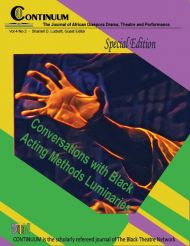Editorial Notes:
Reaching Beyond Borders
In this, our third volume of Continuum, we attempted to reach out to scholars and practitioners working outside the United States. We were particularly interested in essays from Africa, the point of inception for an evolving critical vocabulary that takes into account not only African cosmology and cultural retentions in the creative expressions of theatre artists and scholars throughout the diaspora, but also the efforts of playwrights and practitioners based in Africa to create work that deals with the realities of existence on the continent in the twenty-first century. As the official publication of the U.S.--based Black Theatre Network and an open-access journal, Continuum is poised to break down geographic boundaries so that theatre scholars and artists in Africa and throughout the diaspora have a platform on which to share our work. So far, our efforts to solicit essays from outside the U.S. have not been as successful as we have hoped despite the fact that there exists in many parts of Africa and the diaspora robust communities of artists who are making theater, often under difficult circumstances.
Among the reasons for this apparent dearth of scholarship about African and diaspora theater and the performing arts outside the United States is that theatre artists anywhere in the world who have the time, training, and resources to both practice their art and write critically about it are few and far between. Researching and writing about theatre is primarily the role of scholars and critics. Those who specialize in African and diaspora theater studies are generally based in colleges and universities in North America and the United Kingdom. Many of them are reaching retirement. At the same time, employment opportunities for young scholars in theatre studies are steadily dwindling. [1] They therefore are pursuing careers in higher education that offer greater possibilities for employment.
Another reason, particularly as it relates to Africa, is that theatre in many African does not always happen on a proscenium stage before an audience of quiet spectators. For example, in Nigeria where a strong tradition of literary drama has existed since 1960 when the playwright Wole Soyinka founded Masks, his semi-professional theatre troupe, Nigerian theatre in the twenty-first century is beginning to return to its roots in the country’s long tradition of improvised vernacular community-based theatre. As the scholars Dapo Adelugba and Olu Obafemi explain in their chapter on Nigerian theatre for Martin Banham’s A History of Theatre in Africa, this form of popular theatre
aims to offer an alternative approach and medium by which theatre can be of direct service to the marginalised urban and rural peasant masses. This tradition, which sees theatre as a forum of democratic struggle and which emphasises community, inter-personal participation in self-realisation has begun to gain a slow ascendancy in a large number of communities in Nigeria. It uses the existing and familiar performance forms of the various communities, such as songs, dances, music, storytelling, puppetry and mime, both to validate those cultural forms and to serve as an adequate instrument to bring about social change within these communities. [2]
These unscripted plays are developed and performed for the community by members of the community. They are what Kathy A. Perkins describes as “collective creations.” Perkins explains this process of “playmaking” in the introduction to her anthology, African Women Playwrights (reviewed in this issue): “A collective creation text, adapted to specific audiences and performed in a variety of local languages, is constantly in flux, making publication and translation a challenge.” [3] The lack of a script or video recording of these performances is a major hindrance for scholars and critics writing about African theatre today who don’t have the benefit of experiencing them first hand.
The two essays included in this issue of Continuum, Artisia Green’s “The Blood Remember Don’t It?”: The Ethnocultural Dramatic Structure of Katori Hall’s The Blood Quilt,” and Riah Werner’s “Girl’s Voices in Community Action Theatre in Tanzania,” both engage with Africa, but in very different ways. Green’s reading of The Blood Quilt relies on African, or more precisely, Yoruban mythologies, rituals, and aesthetics embedded in cultural expressions among Gullah communities in South Carolina and the Georgia Sea islands. Green writes that although Katori Hall visited several Gullah communities as part of her research on “Africanist reminiscences,” while working on The Blood Quilt, Hall claims that she did not intentionally locate the play within the Odù Ifà, the traditional Yoruban divination system. Green argues that the patterns of Ifà divination and ritual practices she uncovers in her reading of The Blood Quilt are derived from what Hall calls “blood memory.” Having grown up in a part of the South that is steeped in African-inspired spirituality, the forms of creative expression that spilled out onto her play, and which Artisia Green so eloquently interprets, are in her blood, running down through generations of Africans living in this part of the diaspora.
Riah Werner’s essay, “Girl’s Voices in Community Action Theatre in Tanzania” documents the kinds of theatre practices that Dapo Adelugba and Olu Obafemi and Kathy A. Perkins discuss in their respective essays on African theatre. Working as a Peace Corps volunteer at a rural secondary school, Werner, who holds a BFA in Theatre from New York University and who speaks Swahili, was asked to help create a play with a group of girls that would be performed at their graduation. In her essay, Werner addresses some of the issues and problems about language and community involvement that make these plays difficult to publish. As a participant/observer, Werner presents an ethnographic account of how theatre is being used to promote social justice and equity for girls in a rural Tanzanian community.
Among the books that were reviewed for this issue, two deal directly with Africa: Kathy Perkins’ edited anthology of plays, African Women Playwrights and The Athenian Sun in an African Sky by Kevin J. Wetmore, Jr. These and other books about theatre and performance in Africa and the diaspora are listed on the Black Theatre Network’s website. We invite readers to visit the site and to consider contributing a review to the journal. We also seek production reviews of plays and performances from outside the U.S.
There is a small but vibrant African Diaspora theatre movement north of the U.S. border, in Canada. The Obisdian theatre (http://www.obsidiantheatre.com/) and the Black Theatre Workshop (http://www.blacktheatreworkshop.ca/ )are Canada’s oldest black theatre companies. We look forward to including production reviews of these companies’ works in future issues of Continuum as we reach beyond borders to a global community of people who love to read and write about the making of African and diaspora drama, theatre, and performance.
Sandra Adell, Editor
[1] According to the 2013-2014 Modern Language Association’s Job Information List Report, only seventy-nine jobs were posted in the Film, Drama, and Speech category for all of North America. This is for all ranks, including non-tenure positions.
[2] Martin Banham, ed. A History of Theatre in Africa (Cambridge: Cambridge University Press, 2004), 138-158.
[3] Kathy A. Perkins, ed. African Women Playwrights (Urbana and Chicago: University of Illinois Press, 2009), 3.


